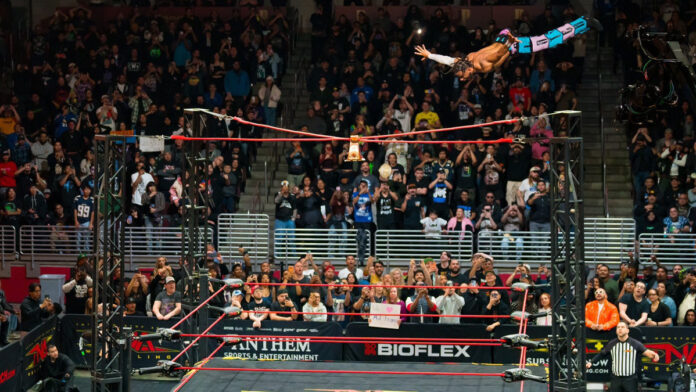Wrestling legend Eric Bischoff has offered a measured perspective on the controversial high-risk spots that have become increasingly common in professional wrestling, suggesting that many performers may be taking unnecessary risks for diminishing returns.
On the latest episode of his “83 Weeks” podcast with co-host Conrad Thompson, Bischoff addressed a recent controversial spot from a TNA pay-per-view – Leon Slater’s crash-out 450-splash at TNA Rebellion.
While acknowledging he hadn’t seen the specific incident, Bischoff provided thoughtful commentary on the broader issue of dangerous stunts in wrestling and the responsibility of both performers and promotions.
“Unfortunately, guys put themselves in positions where they’re doing things that they either shouldn’t be doing because they don’t have the experience, or they’re just too inherently dangerous for what you… the risk-reward factor is out of freaking whack,” Bischoff explained.
WCW’s Cruiserweight Legacy and Today’s High-Flying Style
The conversation prompted Bischoff to reflect on his own role in popularizing high-flying, risk-taking wrestling during his tenure as President of WCW, particularly through the promotion’s influential cruiserweight division.
“Was I an advocate for a lot of the high-flying dynamic, incredible athleticism that the Luchadors brought to the table? Yes, absolutely,” Bischoff acknowledged. “It’s one of the things I’m most proud of as a cruiserweight division because it’s one of the things that I think doesn’t get the credit even I should have given it at the time into making Nitro such a unique format.”
Bischoff went further, asserting the lasting influence of WCW’s cruiserweight innovation on contemporary wrestling:
“That cruiserweight division and the people that we brought in for it is the reason that you’re seeing 70% or 80% of the wrestling presentation that you’re seeing today.”
This acknowledgment makes Bischoff’s caution about excessive risk-taking particularly noteworthy, given his role in helping popularize a more athletic, high-risk style.
“There is an element of does it make sense and is it safe doing crazy high-risk insane maneuvers for the sake of doing them when perhaps some people shouldn’t be doing them because they don’t have the experience,” he questioned.
While celebrating the athletic evolution of professional wrestling that he helped pioneer, Bischoff emphasized that spectacular spots should never come at the expense of performer safety. “Wrestling is so much more than that,” he stated, referring to the focus on “crazy holy sh*t moments” that sometimes seems to drive modern wrestling presentation.
The discussion highlights an ongoing tension in professional wrestling between spectacular athletic displays and performer safety – a balance that promotions like WWE, AEW, and TNA continue to navigate as audience expectations evolve.
Without directly commenting on the specific TNA incident that prompted the conversation, Bischoff offered a philosophy that could serve as valuable guidance for today’s wrestling landscape: impressive athletic feats have their place, but they must be executed by properly trained performers with appropriate precautions and a clear understanding of whether the potential reward justifies the physical risk.
As the wrestling industry continues to push boundaries in pursuit of memorable moments, Bischoff’s perspective serves as a reminder not to lose sight of the health and well-being of the performers who put their bodies on the line for entertainment.

